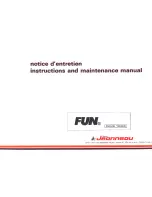
Routine Maintenance
11-1
Section 11
OS 385
Routine Maintenance
11.1 General
Before using a cleaning product, refer to the
product directions and specifications.
If urethane foam is used in the construction
of your boat, be careful with high tempera-
tures or flames in these areas. Urethane
foam can ignite. DO NOT smoke, weld or
burn. Avoid the use of space heaters and
lights in areas where urethane foam is pres-
ent. If ignited, urethane foam burns rapidly,
produces extreme heat, releases hazardous
gases and consumes much oxygen.
11.2 Exterior Hull and Deck
Hull Cleaning - Below the Waterline
When the boat is removed from the water,
clean the outer bottom surface immediately.
Algae, grass, dirt and other marine growth
can be removed easier while the hull is still
wet. Use a pressure cleaner or a hard bristle
brush to clean the surface.
Bottom Painting
If the boat is to be left in saltwater for
extended periods, protect it from marine
growth by applying an antifouling paint.
Because of variations in water temperature,
marine growth and pollution in different
regions, your dealer and/or a qualified boat
yard in your area should be consulted when
deciding what bottom paint system to apply
to your hull, because pollution and marine
growth can damage fiberglass hulls.
Sanding or sandblasting the hull bottom will
damage the fiberglass. Only use standard
antifouling paints and fiberglass wax remov-
ers and primers recommended by the anti-
fouling paint manufacturer when preparing
the hull for bottom paint. Sanding or sand-
blasting and the use of a coating other than
standard antifouling paint or epoxy barrier
coatings are not recommended and will void
the hull blister warranty.
DO NOT allow antifouling paint to contact
the outboard engine. Most antifouling paints
contain copper which will cause severe gal-
vanic damage to the motor. Leave a 1/2"
(12.7 mm) barrier between the hull bottom
paint and outboard engine.
Most bottom paints require maintenance,
especially when the boat is in saltwater or
not used for extended periods, or after dry
storage. If the hull bottom has been painted
with antifouling paint, contact your dealer for
the recommended maintenance procedures.
Sacrificial Anodes
Sacrificial zinc anodes are installed on the
trim tabs, transom and outboard engines.
The transom anode is connected to the
bonding system and protects the underwater
hardware that is bonded.
The anodes are less noble than copper
based alloys and aluminum and will deterio-
rate first, protecting the more noble under-
water hardware against galvanic corrosion.
Anodes should be checked monthly and
changed when they are 75% of their original
size. When replacing the anodes, make sure
the contact surfaces are clean, shiny metal
and free of paint and corrosion. Never paint
over the anode or protect it.
Boats stored in saltwater will require anodes
to be replaced at least every 6 months to
one year. Anodes requiring replacement
!
WARNING
FIRE/EXPLOSION/ASPHYXIATION
HAZARD
Cleaning agents and paint ingredients
can be flammable and/or explosive, or
dangerous to inhale. Make sure venti-
lation is adequate, wear proper per-
sonal protection and dispose of rags
properly ashore.
Vapors from flammable solvents can
cause fire, explosion or asphyxiation
resulting in death or serious injury.
Keep open flame or spark away from
work area. DO NOT paint unless in a
well-ventilated area.
Summary of Contents for OS 345
Page 2: ......
Page 4: ...Operator Notes OS 375...
Page 16: ...12 Operator Notes OS 385...
Page 32: ...3 6 Operator Notes OS 385...
Page 34: ...4 2 Section 4 Electrical System OS 385 Main Distribution Panel MDP...
Page 54: ...5 8 Operator Notes OS 385...
Page 56: ...6 2 Operator Notes OS 385...
Page 98: ...12 6 Operator Notes OS 385...
Page 104: ...A 6 Operator Notes OS 385...
Page 106: ...B 2 Appendix B Maintenance Log OS 385 Date Hours Dealer Service Repairs Maintenance Log...
Page 107: ...Maintenance Log B 3 Appendix B OS 385 Date Hours Dealer Service Repairs...
Page 108: ...B 4 Appendix B Maintenance Log OS 385 Date Hours Dealer Service Repairs...
Page 109: ...Boating Accident Report C 1 Appendix C OS 385 Boating Accident Report...
Page 110: ...C 2 Appendix C Boating Accident Report OS 385...
Page 111: ...Float Plan D 1 Appendix D OS 385 Float Plan...
Page 112: ...D 2 Operator Notes OS 385...
Page 116: ...E 4 Operator Notes OS 385...
Page 117: ...Schematics F 1 Appendix F OS 385 Schematics...
Page 118: ...F 2 Appendix F Schematics OS 385...
Page 119: ...Schematics F 3 Appendix F OS 385...
Page 120: ...F 4 Appendix F Schematics OS 385...
Page 121: ...Schematics F 5 Appendix F OS 385...
Page 122: ...F 6 Appendix F Schematics OS 385...
Page 123: ...Schematics F 7 Appendix F OS 385...
Page 124: ...F 8 Appendix F Schematics OS 385...
Page 125: ...Schematics F 9 Appendix F OS 385...
Page 126: ...F 10 Appendix F Schematics OS 385...
Page 127: ...Schematics F 11 Appendix F OS 385...
Page 128: ...F 12 Appendix F Schematics OS 385...
Page 129: ...Schematics F 13 Appendix F OS 385...
Page 130: ...F 14 Appendix F Schematics OS 385...
Page 131: ...Schematics F 15 Appendix F OS 385...
Page 132: ...F 16 Appendix F Schematics OS 385...
Page 133: ...Schematics F 17 Appendix F OS 385...
Page 134: ...F 18 Appendix F Schematics OS 385...
Page 135: ...Schematics F 19 Appendix F OS 385...
Page 136: ...F 20 Appendix F Schematics OS 385...
Page 137: ...Schematics F 21 Appendix F OS 385...
Page 138: ...F 22 Appendix F Schematics OS 385...
Page 139: ...Schematics F 23 Appendix F OS 385...
Page 140: ...F 24 Appendix F Schematics OS 385...
Page 141: ...Schematics F 25 Appendix F OS 385...
Page 142: ...F 26 Operator Notes OS 385...
Page 143: ......
Page 144: ......
















































